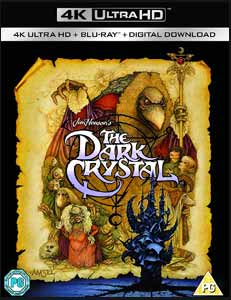|
Click here to return to the main site. Brian Froud (conceptual designer) - The Dark Crystal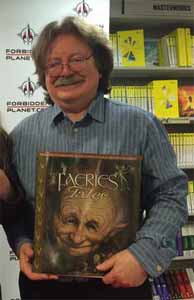 Brian Froud (born 1947) is an English fantasy illustrator. He lives and works on Dartmoor in Devon with his wife, Wendy Froud, who is also a fantasy artist. The couple met while working on The Dark Crystal (1982), where he was the movie's conceptual designer. The landscapes in Froud's paintings are frequently inspired by Dartmoor. Darren Rea spoke with him as The Dark Crystal was reissued in 4K Ultra HD Blu-ray... Darren Rea: Can you quite believe that it's been 36 years since The Dark Crystal was originally released? I was 12 when it came out, so watching it again made me feel really old.
Audiences at the time had never seen anything like it. There was nothing before to compare it with and, I don't think, there's really been anything since that's on a similar scale... What was odd, of course, nobody went to see it [laughs]. When they saw it they weren't sure. But as soon as it came out on VHS and then DVD it's had this extraordinary life of its own. I do think it was absolutely ahead of its time. And now we're knee deep in fantasy films, but then it was kind of quite unusual. It was also unusual because of its darkness; its strangeness [laughs], which has actually been its strength, I think, all these years. To have you design the look and feel of the universe before a script was even really conceived... did that give you any cause for concern as to whether the project would ever see the light of day? Because movies are not usually made like that... No. I don't know what it was exactly that Jim [Henson] saw, well in me in particular. He saw something in the work that he thought would be ideal for the ideas he was developing. I'd been thinking, in those days, about puppets. Seeing what was being done on film - there was a lot of animation - and I though: "Do you know what would be really interesting? If we did a puppet". Only because my designs have a good, strong abstract shape but then there's all sorts of complicated details that go on layer upon layer. And I thought the only way to do it was not to do animation but through doing it for real. And I thought puppets would be ideal.
While he'd seen the art, what he didn't realise was that I could also sculpt and make things. That was really useful in the early days, as we were developing characters, for me to realise it into three dimensions, because that's what everyone was going to. I sort of did that at the beginning by doing little maquetes and working on puppets and costumes and things to give them the look and the feel of it. You were given a huge amount of freedom and closeness to the project. Usually a designer is brought in to create the look and feel and then they release it to others to realise. But you were deeply involved with the entire process... Yes, that was Jim, I think. He really enjoyed people's creative input. And he sort of trusted what was going on. We were pioneering how to do this - we didn't really know. And we were pioneering how to put mechanics in and manipulate them, but we were also finding out how to make them. Jim wanted a new sense of realism to puppetry and that's what we did. But he sort of trusted the process because we sort of knew at the beginning that it was no good me just doing a design and walking away and expecting it to be on the screen. There was trial and error, development of character and development of how we were going to build these things - there was lots of prototype work. My concepts were pretty loose at the beginning and kept shifting subtly as we developed the characters. It was sort of like guiding a ship into port, I suppose [laughs]. Jim sort of trusted that process.
So I'm really grateful for Jim Henson and his vision to allow my input into it. And I think it shows in the film. It has an integrity of look and artistic vision. Did you get the same freedom on Labyrinth? Yes. After doing The Dark Crystal we were never going to do another film again [laughs] because we were so exhausted by it. I was in a limousine with Jim and my wife Wendy and we'd just been to a showing and Jim said: "Shall we do another one?" And we sort of blindly said yes. And that's where we came up with the idea of doing goblins and the idea for the film, in the short time in the back of the limousine. I came back to England and I started to paint pictures, just ideas for it. And from there he started to develop characters and the script. Jim liked, like we did in The Dark Crystal, developing a world. For The Dark Crystal we developed the whole world and the characters within it before we were clear about where that journey within the world was going to take us, within the story. You did an audio commentary on the Blu-ray release of The Dark Crystal. And you talk about how Jim visited you at your home on Dartmoor and was so inspired with the Moors that he urged you to incorporate the look and feel into the movie...
It is the idea that rocks have an energy. Jim loved British mythology and he liked the esoteric side of it. He was interested in Ley lines and standing stones and all the things that are hidden beneath the the ground; the meaning in the landscape. Because I live here, I was able to provide a lot of that for him. Everything was alive. The rocks were alive, the plants are alive and all that got fed into the film. That's the way I approach my own art: to populate the landscape with spiritual beings. And that's sort of what we did with The Dark Crystal. The Mystics are part of the landscape, they seem like they're made of the rock. The first thing we shot on the film was the Mystic Valley and the Mystics walking out of the Valley and because we wanted to know what it would look like on a big screen, we showed the first day's rushes in a cinema in London's Leicester Square. So for about ten minutes we just watched the Mystics walk out of the valley and afterwards Gary Kurtz [co-producer and the second unit director] came up to me shaking his head and said: "I'm so sorry Brian. The Mystics just blend into the landscape." And I said: "Yes! Isn't it wonderful!" [laughs]. It was precisely what I wanted and I think that it was never better than that one moment. Jim had cared enough, our cinematographer had cared enough to try and make it look like one of my paintings. And there it was, come to life on the big screen and it was wonderful. In the commentary you also mentioned that the cinematographer, Oswald Morris, couldn't light it to make it look exactly like your paintings as the picture appeared a little too flat.
My paintings are very flat, they're meant to be flat, and so it didn't work so he had to really dial it back to 10% or something so that there was a hint of it. But once we realised what the problem was, with those colours, I did a lot of design adjusting the colours of the costumes and the landscape, so we did it in camera to make it feel part of that very Froudian [laughs] world. Isn't it true that title, The Dark Crystal, came about after a misunderstanding in the early stages? In the very early days there were about nine of us in the Muppet Workshop in New York. We were starting to work on the film and develop characters, with me drawing. Jim and Frank (Oz) would come by and we'd sit in a circle and start to talk about the characters. Jim and Frank loved monsters and when we were designing the Skeksis and we were describing them, they would always say: "Well, make them worse! Worse is better for them". [Laughs]. We were just fielding around ideas and Jim said to me: "What is this 'Crystal' you keep talking about?" And I said: "That's that central idea..." And he said: "Oh, I was thinking of calling it 'Chrysalis'". The film was about transformation. But this was very early on in our conversation and I assumed it was a crystal and all its ramifications. Then I said "The Crystal" is a bit bland for the name of a film. Why can't we call it something more interesting?" So I came up with the word "Dark" [laughs] and Jim said: "Ooo! That sounds interesting [laughs]. Do you think if Jim hadn't tragically died so young that he would have continued to make pioneering projects with puppets, or do you think that The Dark Crystal was a one off and he would have explored other avenues?
Who knows what he would have done? I don't think he would have necessarily stuck with just pure puppets. We already moved on from The Dark Crystal when we did Labyrinth, with the idea of introducing people. This is the old style Muppets, of having a personality in The Muppet Show with a star that interacted with puppets, and we totally believed that, it was a seamless thing. We did that in Labyrinth and then he moved on and did The Storyteller. I just think that he would have ended up doing something beyond anything we can think of now [laughs] Your son, Toby played the baby in Labyrinth. Is that something he's proud of, or is he embarrassed by it? Oh yes! [laughs]. He often goes to Labyrinth events because of that. But the fact that he grew up surrounded by strange puppets from Labyrinth has given him his direction in life [he's now a puppeteer for movies]. Where you involved with the long in development The Dark Crystal II, which never saw the light of day?
At one stage it was an animation and I've designed things for that, over the years. There's a new TV series currently in development isn't there? That's right. Netflix is doing a prequel [The Dark Crystal: Age of Resistance]. It's a 10-part series. I can't really talk about it [laughs], except that the most exciting thing about it is it's going to be puppets, which is wonderful. So it's come full circle. What's the one creature you've created that you're closest too; that you're most proud of? Oh, right... Er... [Laughs] That's a really hard one. I don't think I can... They're all my children really, so you can't have a favourite with children. I'm really proud of the fact that my life has allowed me to have some association with Jim Henson, who was an absolute genius. And to be part of the physical making of puppets and of films, in particular The Dark Crystal, which has really made its mark in history. I think that's absolutely amazing and I'm so proud of being part of that. Originally Jim Henson's idea for the Skeksis in The Dark Crystal was inspired by illustrations of the crocodiles in a book about Peter Pan... They were crocodiles and they lived in a palace and what we moved from was reptiles living in some sort of palatial environment and then I moved the reptiles into part turkey, part dinosaur [laughs]. Was it like coming full circle when you then went on to work on the 2003 Peter Pan movie?
I'm always intrigued by Peter Pan and I'm also really intrigued by Tinkerbell and I was pushing the concept of Tinkerbell in a direction they didn't want to go. They just obviously wanted to make her the usual... and I wanted her to be like in the books, strong and feisty and difficult [laughs]. If a movie were to be made of your life, who would play you and who would play your wife, Wendy? Oh... I don't know. Jim Broadbent would be me [laughs] I think... and Wendy would be Meryl Streep.
The Dark Crystal is out now on Blu-ray from Sony Pictures Home Entertainment Click here to buy this 4K Ultra HD Blu-ray - Amazon.co.uk This interview was conducted on 01 March 2018 Return to... |
|---|
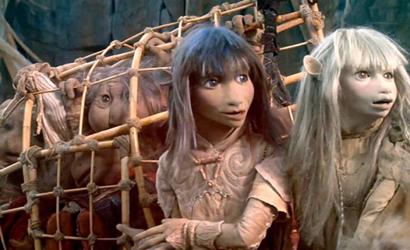 Brian Froud: [Laughs] Oddly enough, I was 12 also [laughs]. I did all my designing in crayons. [laughs].
Brian Froud: [Laughs] Oddly enough, I was 12 also [laughs]. I did all my designing in crayons. [laughs].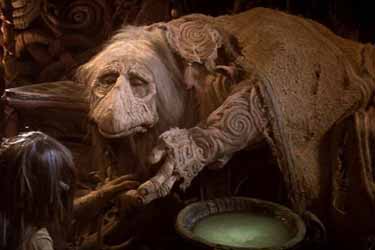 When Jim asked me to be part of it, I was daunted, but I thought I'd have a go [laughs]. Looking back on it, we didn't know how long it was going to take - it took five years in the end. I must have been doing something right from the very beginning, because Jim didn't fire me [laughs].
When Jim asked me to be part of it, I was daunted, but I thought I'd have a go [laughs]. Looking back on it, we didn't know how long it was going to take - it took five years in the end. I must have been doing something right from the very beginning, because Jim didn't fire me [laughs]. 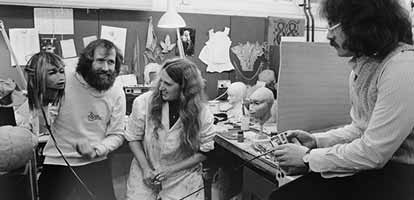 I've been involved with very few films since then, but it's usually in some stage of the design, and it's really frustrating [laughs], because for me it's that they don't trust what my vision is and they always want a mash-up, I suppose. They throw all sorts of other people in there and pick and choose bits of it. It ends up, as far as I'm concerned, a bit of a mess [laughs].
I've been involved with very few films since then, but it's usually in some stage of the design, and it's really frustrating [laughs], because for me it's that they don't trust what my vision is and they always want a mash-up, I suppose. They throw all sorts of other people in there and pick and choose bits of it. It ends up, as far as I'm concerned, a bit of a mess [laughs].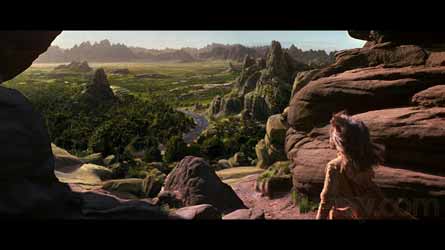 In many ways they've pulled the moisture out [laughs]. There's an American influence, I suppose, so it's a bit drier. Not like damp Dartmoor.
In many ways they've pulled the moisture out [laughs]. There's an American influence, I suppose, so it's a bit drier. Not like damp Dartmoor. 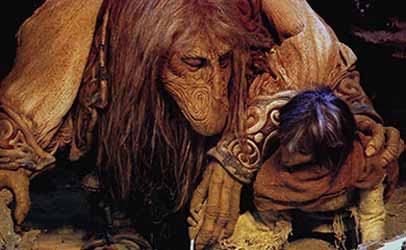 Yes, it was the Lightflex system and when he was using it it just flattened everything out and it looked like there was something missing in the print.
Yes, it was the Lightflex system and when he was using it it just flattened everything out and it looked like there was something missing in the print.  That's a very interesting question. I often ask myself about that, because Jim was always pioneering. He was always off somewhere else doing something [laughs]. He was always exploring new techniques. He was intrigued about computers and using them to propel movement or transmit puppeteering skills to puppets. I think what he really wanted was to write interesting stories or have stories that would impart something that would be good for the world.
That's a very interesting question. I often ask myself about that, because Jim was always pioneering. He was always off somewhere else doing something [laughs]. He was always exploring new techniques. He was intrigued about computers and using them to propel movement or transmit puppeteering skills to puppets. I think what he really wanted was to write interesting stories or have stories that would impart something that would be good for the world.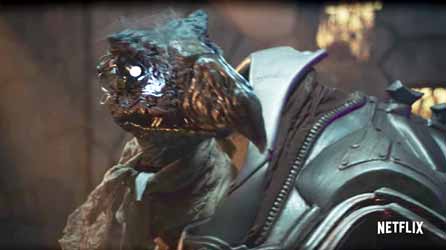 Yes. Over the years there's been several attempts to do a project based on The Dark Crystal.
Yes. Over the years there's been several attempts to do a project based on The Dark Crystal. 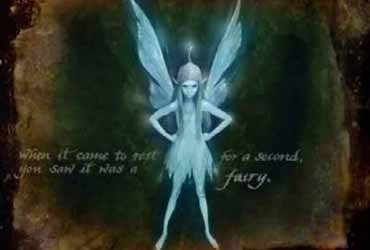 I did do a little work on Peter Pan... er...but they didn't really use it [laughs]. The best bit of Peter Pan was meeting P. J. Hogan [director]; having lunch with him and having a really good time.
I did do a little work on Peter Pan... er...but they didn't really use it [laughs]. The best bit of Peter Pan was meeting P. J. Hogan [director]; having lunch with him and having a really good time.